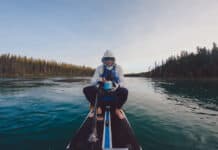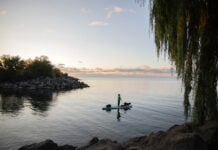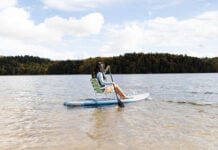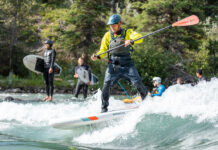Last time I went paddleboarding I saw a curious thing. I walked past the usual waterside coterie of folks diligently pumping up their paddleboards. That was not unusual. I’m used to envious looks from people when they see a board that comes with the air already inside it.
Next, I encountered someone paddling their board while seated. That was also not unusual. I have seen so many people not standing on standup paddleboards that I already thought these watercrafts should have been named differently.
No, what was unusual was this person was seated on a lawn chair. On a lawn chair on their paddleboard. And propelling himself with a kayak paddle.
Trendsetters: Why the future of standup paddleboarding is sitting down
At first, I was horrified. “That is no longer a SUP,” I thought. But then I reconsidered and realized what I was witnessing was evolution putting the lie to our cognitive bias that assumed standup paddleboarding was a good idea in the first place.
From the standards of SUP paddling, this guy looked patently ridiculous. He was breaking every rule. But from a practical perspective, his choice was hard to argue. We modern Western Darwinists can be forgiven for buying into the notion that standing up to paddle might somehow be superior—more advanced, as it were, on paddling’s evolutionary continuum. But we now know that evolution is not a continuum. It’s a tree with branches, many of which are dead-ends—like the one soon to be occupied by SUPs.

He just might be onto something…
The sit-on-top-paddleboard (SOTP) could become paddling’s next evolutionary leap forward. Think about it. Lawn Chair Man had ingeniously found a way around all the inherent shortcomings of SUP paddling, of which I can tell you there are many.
Sitting on a lawn chair would normally make paddling a SUP rather difficult. But he had solved the problem by replacing his SUP paddle with a double-bladed one, which allowed him to paddle quite powerfully and in a perfectly straight line, despite the crosswind he faced that day, without the awkwardness of changing sides—or trying to do a J-stroke, which is ineffective on a SUP and a faux pas besides. The kayak paddle was obviously a sensible adaptation to the seated position, which itself was a sensible adaptation to the inherent instability of standing up on a SUP in the chop created by said crosswind. Pure genius.
Plus, he was saving himself the peccadillo of holding a SUP paddle backward, the likelihood of which, based on my field observations, would have been about 80 percent. The bent shaft paddle—if I were a SUP manufacturer I would print a graphic on every board with a picture of the correct way to hold one of these things. On second thought, I would never have made bent shafts in the first place. The consequences of unleashing such a complex device onto the paddling public are just too great. Yes, I know the long lever of the SUP shaft magnifies the inefficiency of a straight blade and makes the SUP stroke particularly needful of the bent shaft’s advantages. But not if you hold it backward, my friend. And not if you are already on your knees.
The human mind has certain cognitive or perceptual errors baked-in, one of which is the tendency to pick up a bent shaft paddle and assume it works like a scoop, and to hold it backward. Spread out over the course of SUP history—factoring in the sum total of all those wrong strokes—the bent shaft likely works out to be a net disadvantage. And when you consider all the first-timers who ended up scooping water behind them and concluding, “This sport is too difficult,” I argue the sport would have grown even more popular had there been no wrong way to hold the paddle, whatever the efficiency cost.
My brilliant friend in the lawn chair may have been one of those people. He probably got his new board, took a few strokes on one side with his paddle held backward, spun in a circle and then fell headfirst into the water. “Enough of this nonsense,” he then thought, and started down the road of practical adaptations. And you could tell he was a practical guy, because he didn’t go for an inflatable paddleboard either. “How is this supposed to be relaxing if I have to blow it up first, and then deflate it to take it home, and then blow it up again to dry it out, and then deflate it again to store it?” he probably concluded. And I’m inclined to agree. Inflatables: a surefire way to spend more time pumping than paddling. Brought to you by the makers of the bent shaft paddle.
You can’t fight gravity
As I said before, the whole “stand up” moniker was probably a mistake to begin with. Because on a SUP, even if you are on your feet, you are not in fact supposed to be standing. Athletic Crouch Paddleboard probably didn’t have the same ring to it. But look how any expert SUP surfer holds a sort of half-squat. If their body could talk it would be saying, “If I had a lawn chair mounted on this thing, I’d park my butt right here.”
And that’s how you see them on a Sunday afternoon, drifting about lazily with their heads held high and their paddles facing the wrong way and their PFDs strapped to the deck.
Beginners don’t get this. They hear the words “stand up” and they take it verbatim. They go out and presume they’re supposed to be completely upright. And that’s how you see them on a Sunday afternoon, drifting about lazily with their heads held high and their paddles facing the wrong way and their PFDs strapped to the deck—because isn’t that what those bungies are for? [Public Service Announcement: The bungies are not for holding your PFD, you are. May we recommend a waist belt or highback PFD for greater comfort while seated.] They’re going exactly nowhere, but looking damned stylish in their swimsuits while doing it… until an offshore breeze picks up.
As all things in the universe tend toward entropy and collapse, so too the days of the SUP are limited. Greater forces are propelling it to return to its sit-down paddling roots. You can’t fight gravity and, like Lawn Chair Man, eventually everyone figures out the lower you go, the more stable you are. And there is nothing more stable than sitting down. Kayakers knew this all along of course, but they have to deal with their own shortcomings—a proclivity to fill with water and an uncomfortable sitting position.
SUP paddlers, the time has come to buy yourselves a lawn chair and kayak paddle. Then you can set off—in a perfectly straight line!—into the future of paddlesport.
What’s next you ask, two blades? Probably. | Feature photo: Courtesy Level Six // Five2Nine



 This article was first published in the 2023 Paddling Trip Guide.
This article was first published in the 2023 Paddling Trip Guide. 





Not sure evolution is the right word: from what I’ve read and been told sit-on-top kayaks developed from somebody putting a lawn chair on an SUP, so this is more of a regression. Been there, seen it, done it, and you can buy the result in Walmarts and Costcos all around the country. But perhaps my sources were just mistaken?
Putting a seat on a paddleboard is a great option. A key word being _option_, because standing up is not going to go away. The sit-down option (or is it sit-up option?) does indeed introduce another great choice: single-bladed versus double-bladed paddle. While there are _some_ hybrid paddles out there, a great opportunity for paddle manufacturers would be to offer good quality paddles that can transform between SUP and kayak (or single- & double-blade) versions. The SUP-specific and kayak-specific design aspects would each have to be modified towards a good compromise, but i’d rather buy one versus having to bring two separate paddles if i want to paddle both ways.
The downside to sitting and using a double-blade paddle that i’ve already seen in so many images and videos: using a paddle that is far too short. People tend to just grab a “standard” length kayak paddle, not realizing that when they sit so high up, on a craft so wide, they really need a paddle that is a good 30-40cm (12-16″) longer than what they would normally use in a sit-in kayak.
This is the most insecure article I’ve ever read. The only person he doesn’t dig at, is himself…
This opinion on SUP is downright ridiculous. The thing about standing up is big fun-factor. And its just more fun, when you need to keep balance – or end up in the water. And you can do all sort of crazy stuff when you stand up. You can jump, you can intentionally crash into other paddler and see who falls down first. I have nothing against kayaking, its great sport as well, but SUP just has that fun spark. The same as with recent electric scooter mania. E-Bikes will continue to be more safe and versatile option, but e-scooters are just more fun.
Ich selbst fahre noch überwiegend im stehen. An einem Tag stellten wir dann mal aus Spaß einen Strandstuhl aufs SUP und alle Anwesenden fanden es total cool und lustig. Plötzlich fingen im Freundeskreis auch die am SUP fahren Gefallen zu finden, die sich zuvor niemals auf ein Board gestellt hätten. Als die ersten Paddler im Freundeskreis nun so unterwegs waren, wurden wir immer wieder von Neugierigen angesprochen wie das sich so fährt und was man dafür an Equipment benötigt. Und um all die vielen Fragen dazu zu beantworten ist diese Seite von mir dazu ins Leben gerufen worden. http://www.sit-down-paddleboarding.com. Viel Spaß beim selber einmal ausprobieren. Beste Grüße. Hartmut